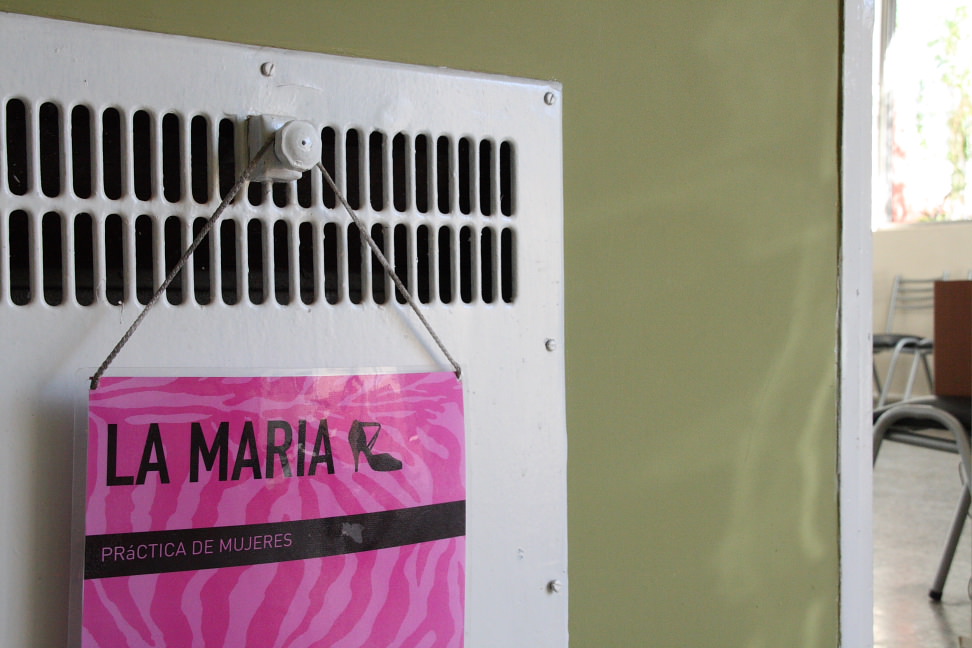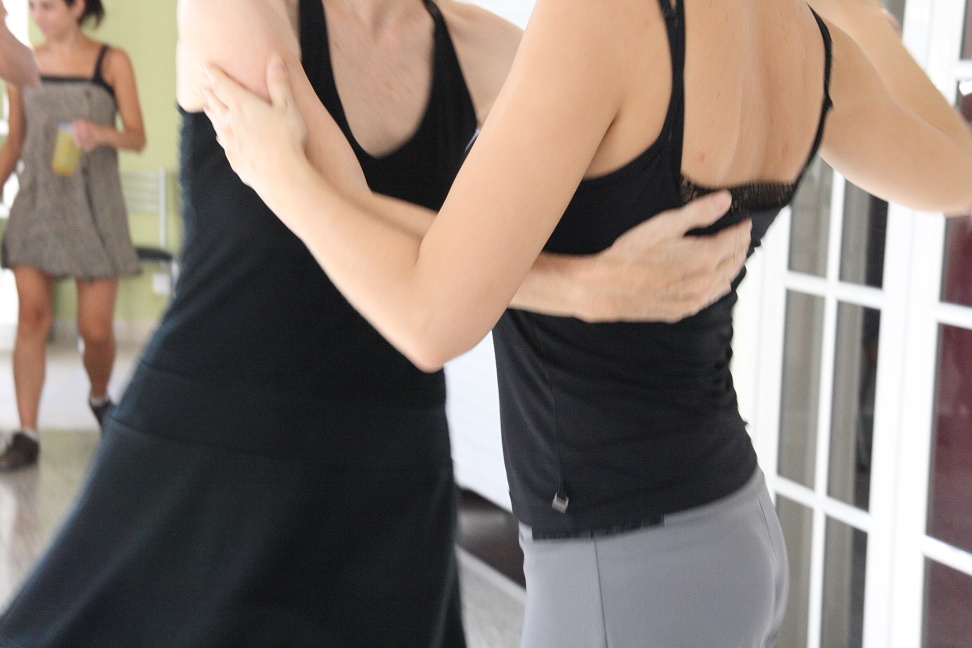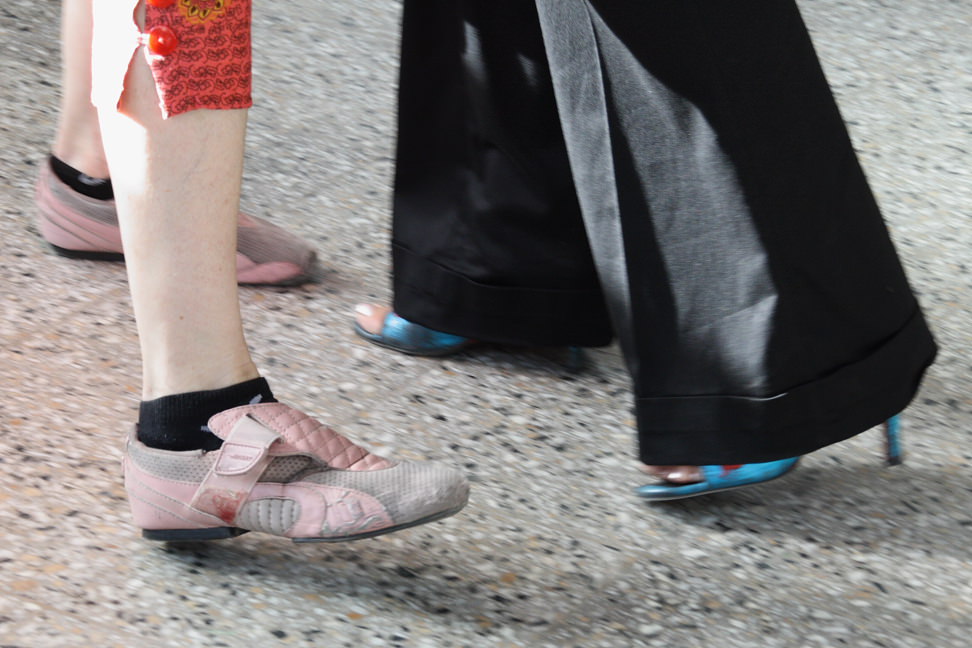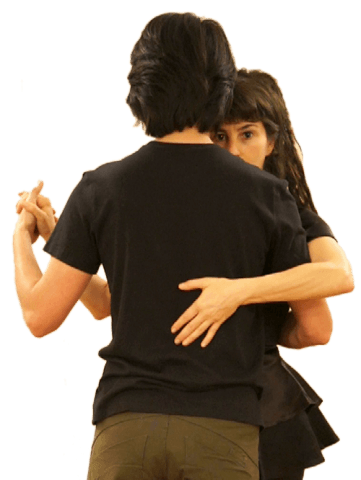Why we need feminist tango: Dancing gender in Buenos Aires in the Summer of 2010
I understand gay as one form of queer, which includes any creative refusal to do gender as one is expected to. Accordingly, women who lead tango are thoroughly queer. We lead through retrograde spaces of reinvigorated machismo surrounded by resolutely passive sisters who refuse to dance with us. We lead assaulted with retrofitted concepts of virginity: “leading will ruin your following”… We lead in heels, in dresses with sneakers, on Tuesdays but not Thursdays, simultaneously magnifying and collapsing the dualisms of butch and femme. We lead.
 Soon after arriving in Buenos Aires in December 2009, I heard about La Maria, an afternoon practica for women leaders. I was excited to visit and even more excited to interview two of the organizers. We met after the practica on a hot January day and I learned that La Maria is something much different than what I first perceived. But that’s to be expected – it’s tango! In preparing this article I found that I needed to write something other than an interview, because I want to share my own reflections. This article does not represent the organizers of La Maria.
Soon after arriving in Buenos Aires in December 2009, I heard about La Maria, an afternoon practica for women leaders. I was excited to visit and even more excited to interview two of the organizers. We met after the practica on a hot January day and I learned that La Maria is something much different than what I first perceived. But that’s to be expected – it’s tango! In preparing this article I found that I needed to write something other than an interview, because I want to share my own reflections. This article does not represent the organizers of La Maria.
Photographs and translation in the interview by Daniele Perillo (www.danieleperillo.com). Transcription and text translation by Clarissa Gentinetta (clari.genti@gmail.com). You can read the full interview here: Visit La Maria on the web: //lamariapractica.blogspot.com/.
AVISO! La Maria has moved: La Catedral, 4006 Sarmiento esq. Medrano. Lunes 5-7 Miercoles 6-8.
La Maria
La Maria is held in the afternoon, and, unlike other milongas and practicas in Buenos Aires, offers a table of free snacks, shared mate gourds, and tea. The organizers believe that the atmosphere, including the sunlight, is important for making the event friendly and avoiding the conflicts among women which plague the milongas at night.
Every week a guest teacher provides some ideas about a topic, as part of the practica. The organizers experience La Maria as a space of interchange, where “this idea of teacher-student doesn’t exist. It’s like a space for investigation, and it’s very clear that person comes to offer us their tango, but at the same time it’s like a back and forth.” For the organizers of La Maria, he open interchanges of the Practica mean that “many more possibilities of work are opened up…one evolves much more professionally, because obviously more doors are opened.”
The organizers encourage tango with more fluid experience of roles, so that men and women can explore the dance without the confines of expectations about gender. “Interchange, meaning, they must not close themselves to only investigating the man and the woman.”
The project doesn’t feel isolated or marginalized. It has attracted many allies, including a number of what I call local celebrity men – professional and expert dancers of high visibility in the youthful tango scene that swirls around Villa Malcolm, Practica X, Milonga 10, La Viruta, and Milonga Loca. La Maria is part of a circle of co-promotion with organizers of events at these places.
The organizers have put their promotional materials at the gay milongas, La Marshall and Tango Queer, but they have yet to have an exchange with queer tango events, such as teaching or performances. They are not sure if some Queer women come or not but “we have never had a couple of men come here.” They welcome everyone. They believe that it’s beautiful to do the dance with whoever you desire – “awesome and beautiful”.
There are four dimensions of La Maria which I would identify as more-or-less feminist projects. First and foremost in the minds of the women who organize it is the recognition that they can be professionals in tango without a male partner. They can teach “alone or with a woman or with a man”, but most importantly without dependence on a male partner. “If you’re alone, you can also work. It’s not that you need somebody.” The practica itself proves they can initiate projects on their own. This independence has been inspiring to visitors. “Coming here generates the possibility of thinking that you can do things alone…generate new things.” We asked them if they had a message for women all over the world who want to start leading in tango. Their answer was very interesting. “that they not think about it as ‘starting to lead’. I mean, for me the message would be…become autonomous…trust in one’s self and not depend on a man or on a woman or on anybody.”
La Maria is organized to address a specific problem relating to the growth of professional women in tango, which is that they learn to lead moves and sequences in order to teach, but they do not have a space to practice dancing in the traffic of the dance floor. La Maria provides an opportunity to practice dancing with circulation as in the milonga, “where someday you may be able to go dance, without fear.”
They also act in sympathy with women just starting in tango. Beginning women “suffer” because they don’t “have the possibility of dancing with a man…because of the numbers”. So a practica in which women lead gives the chance for beginning women followers to dance and improve. They point out that historically, “men practiced with men. So it’s not such a crazy idea.”
Fourth, they have an idea that through the more full participation of followers, the dance itself could become less passive for women. “Instead of ‘leading’ it’s ‘proposing’ – be it a man or a woman – propose, and the other person is, ‘ok, let’s go’… There’s not one active person and another inactive… You can even switch in that same moment, say ‘ok, now I propose and you participate.’ It’s much more interactive.”
The organizers find these projects to be very successful. “La Maria definitely a space that opens up. It transforms.” But they point out,
“It’s not that we’re feminists. It has nothing to do with that.”
“– no no no no no no no no no.”
In December 2009, the promotional material for La Maria read “practica para mujeres” (practica for women). But when we did the interview in January 2010, the organizers told me “it changed…. the new cards now say ‘cambio de roles’ (change of roles).” They explained, “In the beginning it was just a practice for women. But men started to ask us if they could come. And we opened the space up to everybody… but the men that come here come with a totally different attitude. They come to have fun, to play, and to investigate…If a man and a woman want to dance together, that’s fine. Basically, though, we make an emphasis on interchange…The gender doesn’t matter…”
My experiences and the claim that “gender doesn’t matter” stimulated some thoughts about the situation and needs of women leaders.
Reflections of a woman leader
The role of men
The weekly practices at La Maria were held in a very small room. (In 2011 they moved to a larger space.) I did feel validated that local celebrity men were there to encourage women leaders, but was it really ok to block their path with my clumsy practice? I felt they were taking up a lot of space.
When asked how they conceptualize the masculine role in their project, the organizers said that the idea is not to put a person within a gender, they “don’t deal with gender”. They are clearly concerned with systemic problems that women face, yet the masculine dimension of tango is neutralized, or avoided.
Although the website indicates that about 1/4 of the invited teachers are women, every time I visited La Maria, a man was teaching. He would be in the center of the room, defining the project. One of these teachers asked me to dance. I wasn’t sure that he was really offering to follow me and stood up hesitantly to find that he was offering to lead me. I thought, ok he’s just going to give me a nice dance, just for fun and generosity. Then he doused me with uninvited feedback about my following.
The one year birthday Fiesta of La Maria was well attended and spacious. I sat with the person who had been the friendliest to me in all my trips to La Maria, a man who also follows. He offered to follow me, but when I hesitated, instead of encouraging me he stood up and constructed the embrace as the leader. After one song I resolutely changed the positions, since regardless of the reformed motto, I come to this space as a woman leader. I struggled with a new move, then he impatiently switched the roles. Expecting that he intended to demonstrate the correct lead I paid attention to his lead, but instead of explaining it, he quibbled with my following, and then did not relinquish the lead for the rest of the song. Relieved when he had to leave, I sat recovering, looking around to see who I might ask to dance, and organizing my courage for another go. But I was interrupted by another man/leader, a friend, who asked me to dance. In the codes of tango it’s not nice to turn down a friend unless for some reason you are absolutely unable to walk, so, again, I followed.
Working with Queer Tango communities, I have found it valuable to invite allies to the space. Students learn and grow with the opportunity to follow or lead more experienced dancers. But for women leaders, this form of “support” seems to displace the project. Creating a space where “gender doesn’t matter” means that much of what will happen will be the same old thing, since that’s what people know how to do. Men show up to support and be nice to women, so they ask women to dance, which is very nice. And if they are an expert they want to “help” us with our following, even when we are trying to focus on leading.
Two failed strategies of dealing with power dynamics are visible here. The first is the attempt to deal with power by asserting a neutral equity. This fails to change the dynamic and also fails to investigate and address the specific needs of those who have been deprived of resources. The second is the charitable attempt to uplift the less powerful, which fails because the people who have held power insist they can and should define the others’ needs. The result of these strategies in this case is that menleaders behave the same way as usual and womenleaders don’t get to articulate and control their own agenda for growth.
Feminist Following
I study at DNI, which is a very loving and joyful tango school. I find this school’s instruction for leaders far more thorough and precise than elsewhere. For three months I have led in one class there every day. The teachers know me and are supportive. A few other women leaders have come through the school on shorter visits in these months, but usually I am the only woman leader in the class. In the lower level classes, sometimes I’m the most experienced leader. Nevertheless, most of the womenfollowers would rather dance with any man, than with me. Many of the women make a small laugh as they consent to follow me.
I went to La Maria expecting haven – encouragement from practice partners and celebration of the project of women leading. Instead, the women who I asked to dance seemed impatient and bored dancing with me, although when I suggested they lead, I found they were no better at it than me. Many women sat sour-faced, just like at the milongas. I wondered who they were waiting to dance with.
Feminist tango of course must also consider feminist following, for those women who have mostly followed men. How do we come to each other from the arms and bodies of men? How do we cultivate trust and surrender to a woman leader who often feels comparatively frail? How do we generate the same patient faith in women leaders’ development that we so easily give to men?

Pedagogy for Women Leaders
I was very fortunate to attend the 3rd Festival International of Tango Queer in Buenos Aires, which took place in December. Long story short, I wept with joy watching so many men dance together AND I was very sad to see few women dancing in the festival milongas. Even the weekly Tango Queer class and milonga here in Buenos Aires has transformed from a small group mostly of women (my observation in Winter 2008), to three or four times as many people, but mostly men. The easy thing to say about this is that Queer men have grown into Tango faster than women, and soon it will change. I very much wish that to be true.
But I believe that women leaders will still be trespassing in the masculinity of tango until we can discuss and explore together why and how we want to enter the space of leading, what we want to use it for, how make it our own, and what shoes we want to wear. There are social, psychological, emotional, and bodily aspects of leading which must be explored from a woman’s perspective.
We need to teach and learn with awareness of different femininities and our psychological perceptions of our bodies. The necessary mix of strength and softness necessary for leading challenges butch ways of inhabiting the body no less than femme ones. We are strong enough to lead, but we often don’t relate to our strength accurately, and that causes all sorts of problems in the embrace and the mark. We need technique for dancing without the advantage of a high body-mass ratio to the partner. We need technique for leading in a wider range of shoes than men use, so that our style is not diminished before we even step onto the dance floor as leaders.
None of classes I attended at La Maria addressed topics specific to women leaders, such as how to use your body to support yourself and another person when they lose their balance, inspiring confidence in followers so they are willing to trust you (for example in colgadas and volcadas), or techniques for dancing with people taller or bigger than you – although several of the men teachers were very small and surely could have spoken to these issues.
Toward a Feminist Tango
I left the Fiesta sure that we need feminist tango, and equally sure that I didn’t know what it would be. There are now spaces where women are “welcome” to lead and women occasionally lead (and men follow) even in some regular practicas and milongas (it happens at all of the places listed earlier in this article). Some men are now encouraging of women leaders and showing more openness to following women. These openings are very important and valuable. But I think we are going to need more than that and that our needs are different than what gay men have needed.

A feminist tango is not anti-man in any way, but it is pro-woman. It means we give each other the same gracious generosity that we habitually and unhesitatingly offer to strange men. It means we give each other more, and what that more can be is open to the imagination of every woman who has suffered the unique and poignant pains of tango. It would mean we see each other as sisters and we know that encouraging confidence and power will expand the space for all of us.
To support women leaders, we need to pay attention to gender, not ignore it. Primarily because we need to give guidance to the men who come to support, so that they can do so effectively. Secondarily, because women need consciousness-raising in order to learn what sisterly behavior is in new contexts. Third, if we are to lead tango well, we need a pedagogy for our bodies, femininities, and desires.














